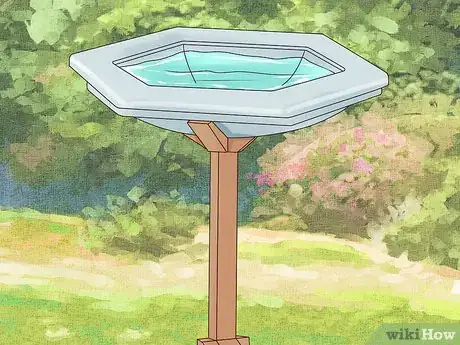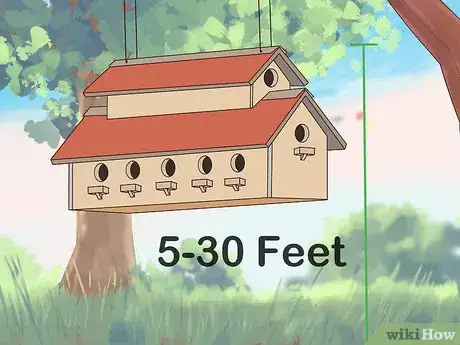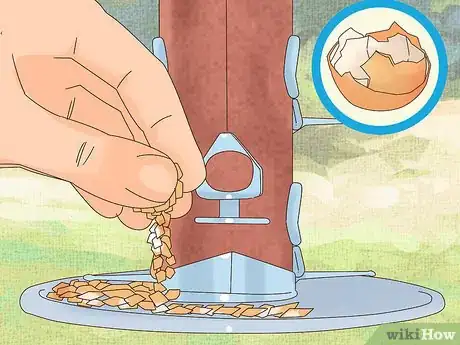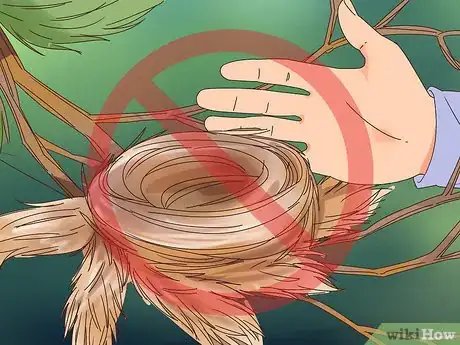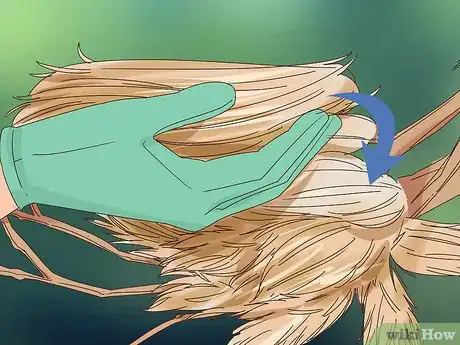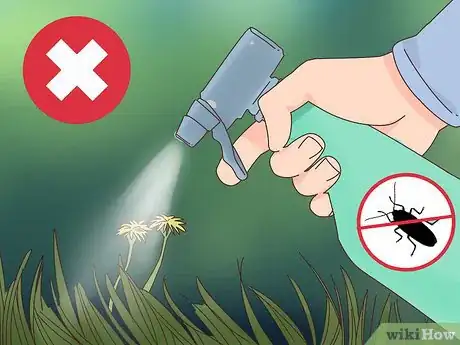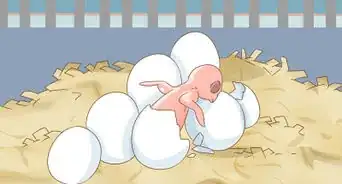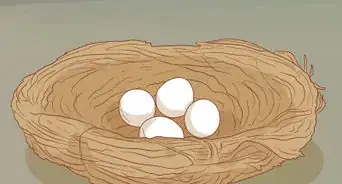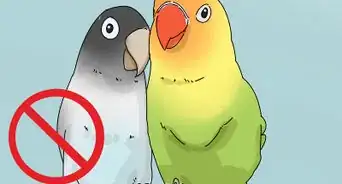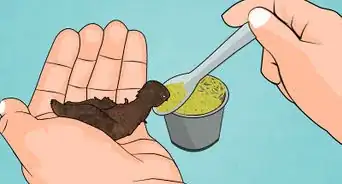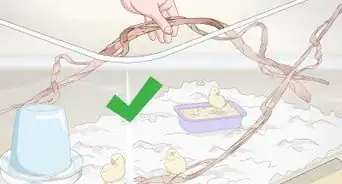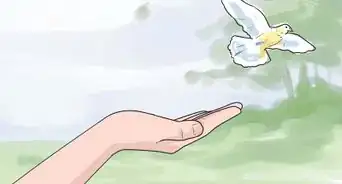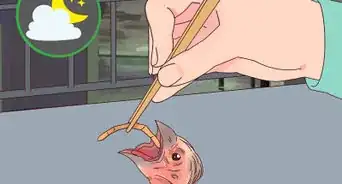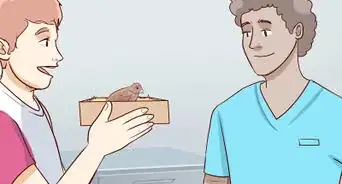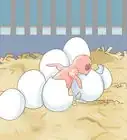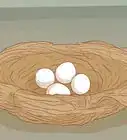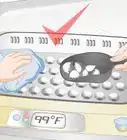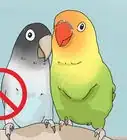This article was co-authored by wikiHow Staff. Our trained team of editors and researchers validate articles for accuracy and comprehensiveness. wikiHow's Content Management Team carefully monitors the work from our editorial staff to ensure that each article is backed by trusted research and meets our high quality standards.
There are 7 references cited in this article, which can be found at the bottom of the page.
This article has been viewed 23,768 times.
Learn more...
Seeing a bird nesting in your backyard is an exciting event that you might want to encourage. Luckily, there are several ways you can help your nesting bird and set it up for success. First, you should create a healthy habitat that has adequate shelter, water, and food. Then, you can take additional steps to keep the bird safe from predators. Creating a safe habitat for a nesting bird will improve the chances of it laying eggs in the spring and summer.
Steps
Creating a Healthy Habitat
-
1Set up a birdbath so the birds can drink and bathe. A birdbath will keep the nesting bird hydrated and will give it a way to cool down. Birds typically enjoy shallow fresh water in the birdbath. Refill the water in the birdbath daily to prevent bugs and wipe it down once a week to keep it clean.[1]
- The average depth of the birdbath should be around 3 inches (7.6 cm) for most birds.
- Wipe down your birdbath with a solution of 9 parts water to 1 part white vinegar once every week. This solution is safe for bird feathers and will clean the birdbath.[2]
-
2Provide a birdhouse or nestbox to give the bird shelter. A birdhouse or nestbox will provide a place for nesting birds to lay their eggs. A nestbox is a plastic or wood box that has an opening on the top. You can buy a birdhouse or nestbox online or at a pet store. Birdhouses and nest boxes should be 5–30 feet (1.5–9.1 m) above the ground and can be attached to a smooth pole or on a tree, away from hanging branches. This will prevent predators like squirrels and raccoons from accessing the nest.[3]
- You can buy a traditional birdhouse, just make sure it is big enough for the type of bird that’s nesting near you.
- You can also use a wooden box or wicker basket as an alternative to a nestbox.
- Placing the birdhouse next to branches on trees gives squirrels and other bird predators easy access to it. Keep them at least 10 feet (3.0 m) away from branches.[4]
Advertisement -
3Leave dry twigs, leaves, and grass out for nesting material. The birds will need something to create their nest with. Dried twigs, leaves, and grass are all safe materials for the birds. Place the materials in a pile outside or drape them over vegetation in your yard.[5]
- You can also leave out human or animal hair for the nest.
- Do not put out tinsel, plastic, or tin foil because it’s unsafe for birds.
-
4Fill a birdfeeder with foods that contain a lot of protein. Suet, mealworms, and peanuts are high-protein foods that will give the birds a lot of energy as they nest. This will also provide a healthy food source that the nesting birds can use for their young once the eggs hatch. Place the birdhouse on a pole or high tree at least 10 feet (3.0 m) away from any hanging branches.[6]
- Refill the birdfeeder as it gets empty.
-
5Put out eggshells for added calcium. Eggshells will replace the calcium that’s expended when the female bird lays eggs. Dry out eggshells in the oven at 250 °F (121 °C) for 15-30 minutes, then crush them up into tiny pieces. Sprinkle the shells outside so that the birds eat them and supplement their natural calcium.[7]
Keeping the Birds Safe
-
1Do not approach the nest or touch the nest. Visiting the nest could leave your scent, which could attract predators. While it may be tempting to get a closer look at the nest, revisiting the area could put the bird and hatchlings in danger.[8]
- Approaching a nesting bird may scare it away.
-
2Place a nestling back in the nest if it falls out. While you shouldn’t normally touch or approach the nest, a fallen nestling could be in danger. Wear a pair of gloves when handling the hatchling so you don't leave your scent on it. Then, save the hatchling by carefully lifting the bird and placing it back in its nest.[9]
- Most birds will get spooked after their nest is disturbed. It may take several hours for the bird to return to the nest.
-
3Keep cats and dogs away from the nest. If you have pets, you should keep them inside or away from the birds' nest. Cats will not only disrupt the nest, but they may also kill the hatchlings or break the eggs in the nest. If you have a dog, keep it on a leash so that you don’t scare or stress out the nesting bird.[10]
-
4Don’t use pesticides or herbicides in your yard. Herbicides and pesticides could be lethal to smaller birds. They may also use the herbicide-covered foliage to create their nest, which is unhealthy for the hatchlings. Avoid using these harmful chemicals in the months of spring and summer, as this is when birds will be nesting.[11]
- Don’t cut shrubs and plants so that different birds can use the leaves and branches to create their nests.
Community Q&A
-
QuestionWe live in Lakewood, NJ and noticed Eastern bluebirds at our suit feeder. Where can we get info regarding nesting houses and where to locate them?
 Community AnswerI have gotten several BB boxes from Walmart. It's a bit late in the season to put them up, but you could try. Go online to learn where and how to put them up. There are several predators that will try to invade the boxes. I have a feeder for the blue birds, and in it I put dried meal worms and peanut suet that I have crushed up for them. The suet and dried meal worms I also get from Walmart, but it is the peanut dough.They love it! So do some other birds.
Community AnswerI have gotten several BB boxes from Walmart. It's a bit late in the season to put them up, but you could try. Go online to learn where and how to put them up. There are several predators that will try to invade the boxes. I have a feeder for the blue birds, and in it I put dried meal worms and peanut suet that I have crushed up for them. The suet and dried meal worms I also get from Walmart, but it is the peanut dough.They love it! So do some other birds. -
QuestionI found an abandoned nestling. I can't identify the type, but it is continuously making noise and opening its mouth. What do I do to help?
 Community AnswerIf you can locate the nest and get to it, put the bird back in the nest. If you can't get to the nest, take a basket and try to hang it near the nest (after putting soft cloth in the basket). Chances are the parents will hear the baby and start taking care of it. If you want to try to feed it, put wet dog food on a popsicle stick and feed it that way. They need protein to grow. They also need to be fed every hour for a long time, so if you don't have that kind of time, don't start. Look for a bird/wildlife center near you.
Community AnswerIf you can locate the nest and get to it, put the bird back in the nest. If you can't get to the nest, take a basket and try to hang it near the nest (after putting soft cloth in the basket). Chances are the parents will hear the baby and start taking care of it. If you want to try to feed it, put wet dog food on a popsicle stick and feed it that way. They need protein to grow. They also need to be fed every hour for a long time, so if you don't have that kind of time, don't start. Look for a bird/wildlife center near you. -
QuestionI made a nestbox but without bird food in it but still I haven't seen a single bird on it. Any advice?
 Aryana RosestarCommunity AnswerIt'll probably take some time. You can leave some food lying around it so birds will find interest in it. Eventually a bird will discover it.
Aryana RosestarCommunity AnswerIt'll probably take some time. You can leave some food lying around it so birds will find interest in it. Eventually a bird will discover it.
References
- ↑ https://www.birdwatchersdigest.com/bwdsite/learn/top10/nestingbirds.php
- ↑ https://www.audubon.org/news/why-you-should-keep-your-birdbath-clean
- ↑ https://www.birdwatchersdigest.com/bwdsite/learn/top10/nestingbirds.php
- ↑ https://nestwatch.org/learn/all-about-birdhouses/features-of-a-good-birdhouse/
- ↑ https://www.allaboutbirds.org/providing-nest-material-for-birds-dos-donts/
- ↑ https://www.birdwatchersdigest.com/bwdsite/learn/top10/nestingbirds.php
- ↑ https://www.birdwatchersdigest.com/bwdsite/learn/top10/nestingbirds.php
- ↑ https://audubonportland.org/wcc/urban/babybirds
- ↑ https://audubonportland.org/wcc/urban/babybirds
